door lock Citroen BERLINGO MULTISPACE 2015 2.G User Guide
[x] Cancel search | Manufacturer: CITROEN, Model Year: 2015, Model line: BERLINGO MULTISPACE, Model: Citroen BERLINGO MULTISPACE 2015 2.GPages: 298, PDF Size: 12.69 MB
Page 28 of 298
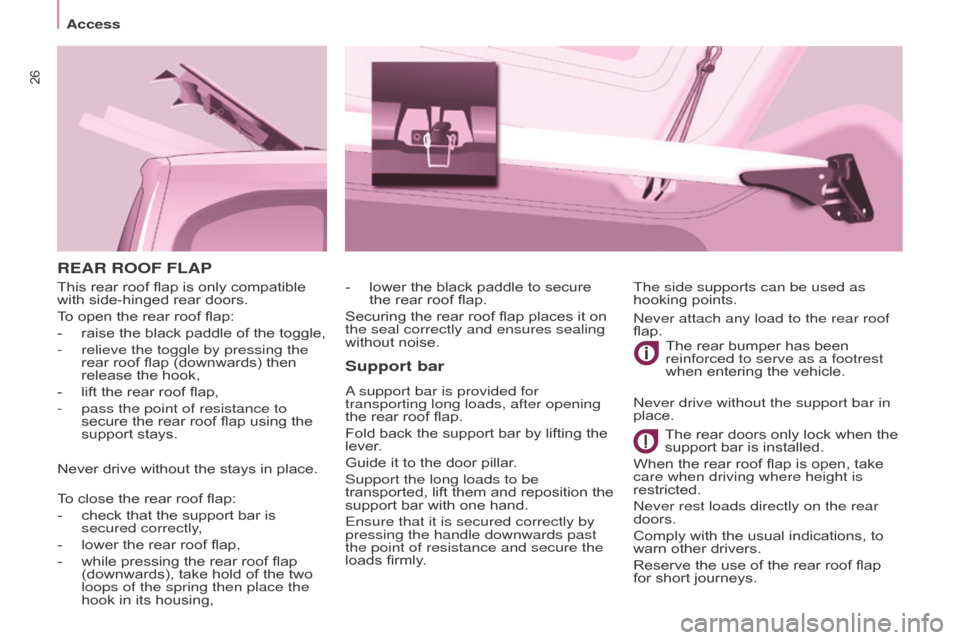
26
Berlingo-2-VP_en_Chap03_Pret-a-partir_ed01-2015
REAR ROOF FLAP
Support bar
a support bar is provided for
transporting long loads, after opening
the
rear roof flap.
Fold
back the support bar by lifting the
lever
.
Guide
it to the door pillar.
Support the long loads to be
transported,
lift them and reposition the
support
bar with one hand.
Ensure that it is secured correctly by
pressing the handle downwards past
the point of resistance and secure the
loads
firmly. The
rear bumper has been
reinforced to serve as a footrest
when
entering the vehicle.
The rear doors only lock when the
support
bar is installed.
When
the rear roof flap is open, take
care when driving where height is
restricted.
n
ever rest loads directly on the rear
doors.
Comply
with the usual indications, to
warn
other drivers.
Reserve
the use of the rear roof flap
for
short journeys.
The side supports can be used as
hooking
points.
-
lower
the black paddle to secure
the
rear roof flap.
Securing the rear roof flap places it on
the seal correctly and ensures sealing
without
noise.
This
rear
roof
flap
is
only
compatible
with
side-hinged
rear
doors.
To
open
the
rear
roof
flap:
-
raise
the
black
paddle
of
the
toggle,
-
relieve the toggle by pressing the
rear
roof
flap
(downwards)
then
release
the
hook,
-
lift
the
rear
roof
flap,
-
pass the point of resistance to
secure
the
rear
roof
flap
using
the
support
stays.
Never
drive
without
the
stays
in
place.
To
close
the
rear
roof
flap:
-
check
that
the
support
bar
is
secured correctly
,
-
lower
the
rear
roof
flap,
-
while
pressing
the
rear
roof
flap
(downwards),
take
hold
of
the
two
loops of the spring then place the
hook
in
its
housing,
n
ever attach any load to the rear roof
flap.n ever drive without the support bar in
place.
access
Page 29 of 298
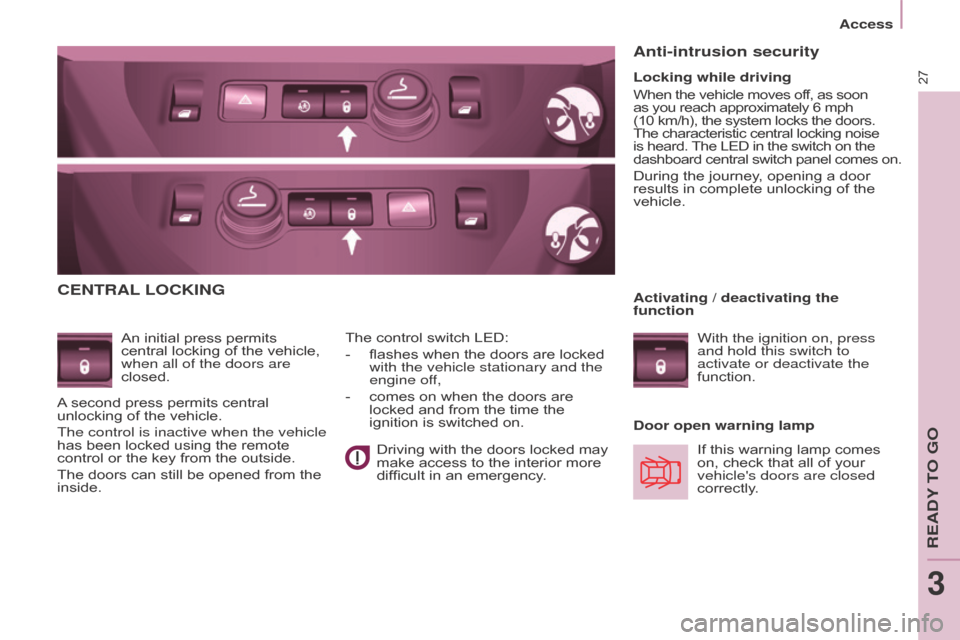
27
Berlingo-2-VP_en_Chap03_Pret-a-partir_ed01-2015
CENTRAL LOCKING
An initial press permits central
locking of the vehicle,
when all of the doors are
closed.
Door open warning lamp
The
control switch LED:
-
flashes
when the doors are locked
with the vehicle stationary and the
engine of
f,
-
comes
on when the doors are
locked
and from the time the
ignition
is switched on.
Anti-intrusion security
If this warning lamp comes on, check that all of your
vehicle's doors are closed
correctly
.
Locking while driving
When the vehicle moves off, as soon as
you reach approximately 6 mph (10 km/h),
the system locks the doors.
The
characteristic central locking noise
is
heard.
The
LED in the switch on the
dashboard
central switch panel comes on.
During the journey, opening a door results in complete unlocking of the
vehicle.
Activating / deactivating the
function
With the ignition on, press
and hold this switch to
activate or deactivate the
function.
Driving
with
the
doors
locked
may
make
access
to
the
interior
more
difficult
in
an
emergency.
A
second
press
permits
central
unlocking
of
the
vehicle.
The control is inactive when the vehicle
has
been
locked
using
the
remote
control
or
the
key
from
the
outside.
The
doors
can
still
be
opened
from
the
inside.
access
REadY To Go
3
Page 37 of 298
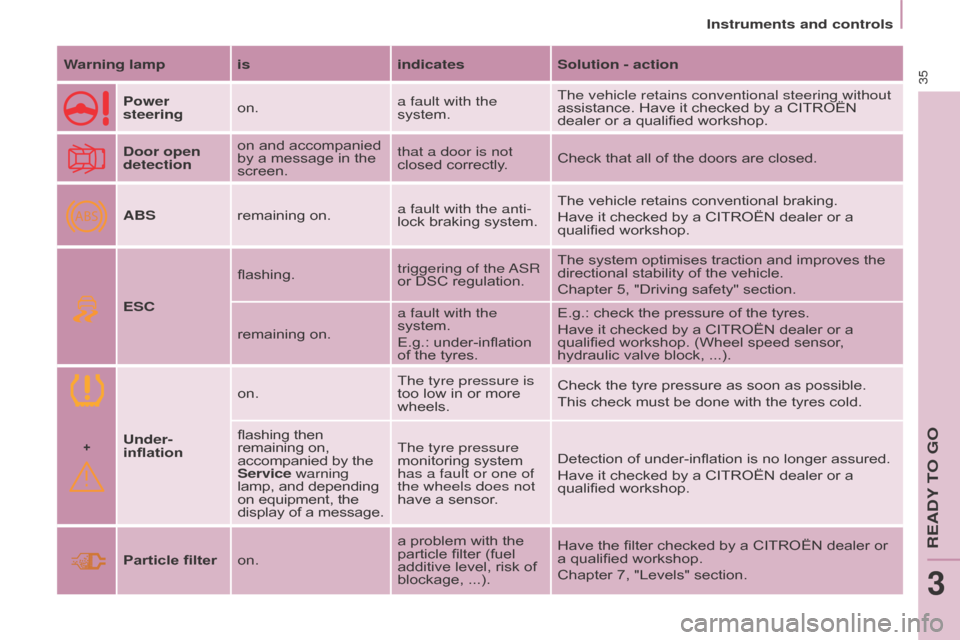
Berlingo-2-VP_en_Chap03_Pret-a-partir_ed01-2015
+
ABS
Berlingo-2-VP_en_Chap03_Pret-a-partir_ed01-2015
35Warning lamp isindicatesSolution - action
Power
steering on. a fault with the
system.The vehicle retains conventional steering without
assistance.
Have it checked by a CITROËN
dealer
or a qualified workshop.
Door open
detection on
and accompanied
by
a message in the
screen.that a door is not
closed
correctly.Check
that all of the doors are closed.
ABS remaining
on.a fault with the anti-
lock
braking system.The
vehicle retains conventional braking.
Have
it checked by a CITROËN dealer or a
qualified
workshop.
ESC flashing.
triggering of the
a
SR
or
DSC regulation.The
system optimises traction and improves the
directional
stability of the vehicle.
Chapter
5, "Driving safety" section.
remaining
on.a fault with the
system.
E.g.:
under-inflation
of
the tyres.E.g.:
check the pressure of the tyres.
Have
it checked by a CITROËN dealer or a
qualified
workshop. (Wheel speed sensor,
hydraulic
valve block, ...).
Under-
inflation on.
The tyre pressure is
too
low in or more
wheels.Check
the tyre pressure as soon as possible.
This
check must be done with the tyres cold.
flashing
then
remaining
on,
accompanied
by the
Service
warning
lamp,
and depending
on
equipment, the
display
of a message.The tyre pressure
monitoring
system
has a fault or one of
the wheels does not
have
a sensor.Detection
of under-inflation is no longer assured.
Have
it checked by a CITROËN dealer or a
qualified
workshop.
Particle filter on. a
problem with the
particle
filter (fuel
additive
level, risk of
blockage, ...).Have
the filter checked by a CITROËN dealer or
a
qualified workshop.
Chapter
7, "Levels" section.
Instruments and controls
REadY To Go
3
Page 54 of 298
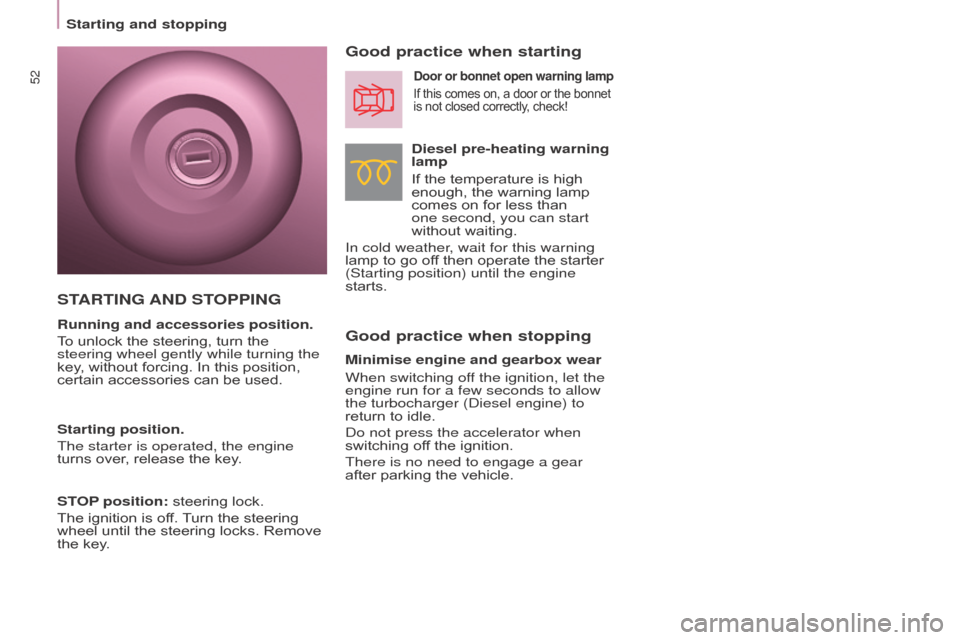
Berlingo-2-VP_en_Chap03_Pret-a-partir_ed01-2015
52
Good practice when stopping Good practice when starting
Diesel pre-heating warning
lamp
If the temperature is high
enough,
the warning lamp
comes
on for less than
one
second, you can start
without
waiting.
In cold weather, wait for this warning
lamp
to
go off then operate the starter
(Starting position) until the engine
starts.
Door or bonnet open warning lamp
If this comes on, a door or the bonnet
is
not closed correctly, check!
Minimise engine and gearbox wear
When switching off the ignition, let the
engine run for a few seconds to allow
the turbocharger (
d iesel engine) to
return
to idle.
d
o not press the accelerator when
switching
off the ignition.
There is no need to engage a gear
after
parking the vehicle.
STARTING AND ST OPPING
Running and accessories position.
To
unlock the steering, turn the
steering wheel gently while turning the
key
, without forcing. In this position,
certain
accessories can be used.
Starting position.
The starter is operated, the engine
turns
over, release the key.
STOP position:
steering lock.
The
ignition is off.
T
urn the steering
wheel
until the steering locks. Remove
the
key.
Starting and stopping
Page 103 of 298

101
Berlingo-2-VP_en_Chap04_Ergonomie_ed01-2015Berlingo-2-VP_en_Chap04_Ergonomie_ed01-2015
Automatic switching on/off
The front courtesy lamp comes on when the key is removed from the ignition, when the
vehicle is unlocked, when one of the
front doors is opened and for location of
the
vehicle using the remote control.
It goes off gradually after the ignition is
switched on and when the vehicle is
locked.Front seats: comes on when one of the front doors is
opened. These are switched on and of
f by
means of a manual switch, with
the
ignition on.
Rear
seats: comes on when
one of the rear doors is
opened.
If
the doors remain open for
a
few minutes, the courtesy
lamps
go off.
Permanently
off.
Permanently
on,
ignition
on.
Front courtesy lamp
COURTESY
LAMPS
Rear courtesy lamp Front individual reading lamps
EaSE oF USE and CoMFoRT
4
Practical information
Page 145 of 298
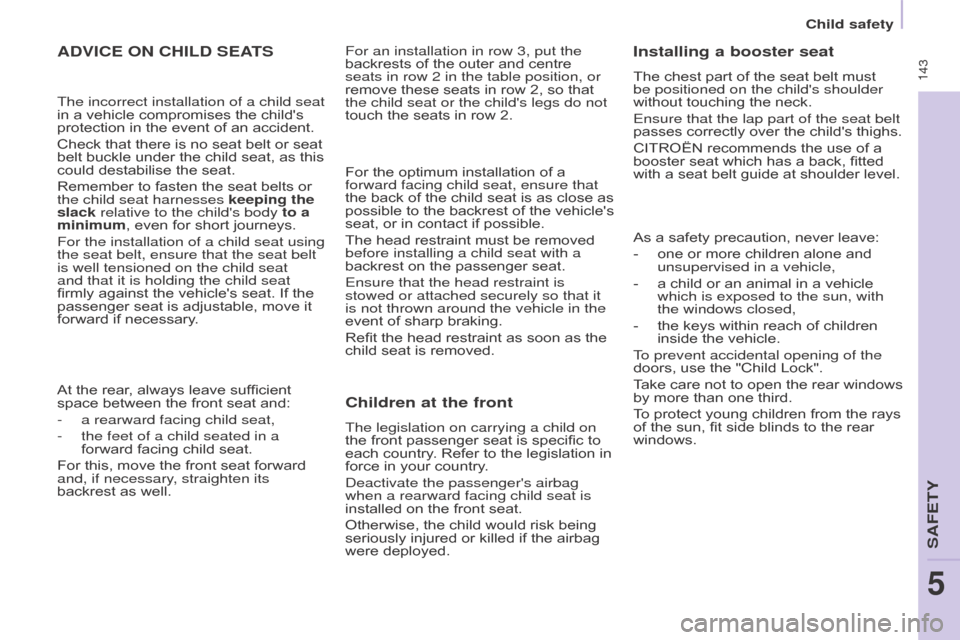
Berlingo-2-VP_en_Chap05_Securite_ed01-2015
143
ADVICE ON CHILD SEATS
At the rear, always leave sufficient space between the front seat and:
-
a rearward facing child seat,
-
the feet of a child seated in a
forward
facing child seat.
For
this, move the front seat forward
and, if necessary
, straighten its
backrest
as well.
The incorrect installation of a child seat
in
a vehicle compromises the child's
protection
in the event of an accident.
Check that there is no seat belt or seat
belt
buckle under the child seat, as this
could
destabilise the seat.
Remember to fasten the seat belts or
the child seat harnesses
keeping the
slack relative to the child's body to a
minimum, even for short journeys.
For the installation of a child seat using
the seat belt, ensure that the seat belt
is well tensioned on the child seat
and that it is holding the child seat
firmly against the vehicle's seat. If the
passenger
seat is adjustable, move it
forward
if necessary. For the optimum installation of a
forward facing child seat, ensure that
the
back of the child seat is as close as
possible
to the backrest of the vehicle's
seat,
or in contact if possible.
The head restraint must be removed
before installin
g a child seat with a
backrest on the passenger seat.
Ensure that the head restraint is
stowed or attached securely so that it
is not thrown around the vehicle in the
event of sharp braking.
Refit the head restraint as soon as the
child
seat is removed.Children at the front
The legislation on carrying a child on
the
front passenger seat is specific to
each
country. Refer to the legislation in
force
in your country.
d
eactivate the passenger's airbag
when a rearward facing child seat is
installed
on the front seat.
Otherwise,
the child would risk being
seriously
injured or killed if the airbag
were
deployed.
Installing a booster seat
The chest part of the seat belt must be positioned on the child's shoulder
without touching the neck.
Ensure that the lap part of the seat belt
passes
correctly over the child's thighs.
CITROËN
recommends the use of a
booster
seat which has a back, fitted
with
a seat belt guide at shoulder level.
As
a safety precaution, never leave:
-
one
or more children alone and
unsupervised in a vehicle,
-
a
child or an animal in a vehicle
which is exposed to the sun, with
the windows closed,
-
the
keys within reach of children
inside
the vehicle.
To prevent accidental opening of the
doors,
use the "Child Lock".
Take
care
not
to
open
the
rear
windows
by
more than one third.
To
protect young children from the rays
of
the sun, fit side blinds to the rear
windows.
For an installation in row 3, put the
backrests
of
the
outer
and
centre
seats in row 2 in the table position, or
remove
these
seats
in
row
2,
so
that
the child seat or the child's legs do not
touch
the
seats
in
row
2.
Child safety
SaFETY
5
Page 146 of 298

Berlingo-2-VP_en_Chap05_Securite_ed01-2015
144
CHILD LOCK
This prevents opening of the siding
side doors from the inside.
Manual Electric
With the ignition on, press
this
button in the middle of
the
dashboard.
Indicator
lamp on = child lock
on.
Please
note: this system is
independent
of the central locking
control.Always
remove the ignition key
when leaving the vehicle, even for
a
short time.
It
is
advisable to check the state of
the
child
lock each time the ignition is
switched
on.
In
the
event of a serious impact the
electric
child lock is deactivated
automatically
.
a label indicates the position of the
lever
and
the
state
of
the
child
lock.
-
o
pen fully past the point of
resistance.
-
T
ilt the lever, located on the rear
section
of
the
door.
Child safety
Page 161 of 298
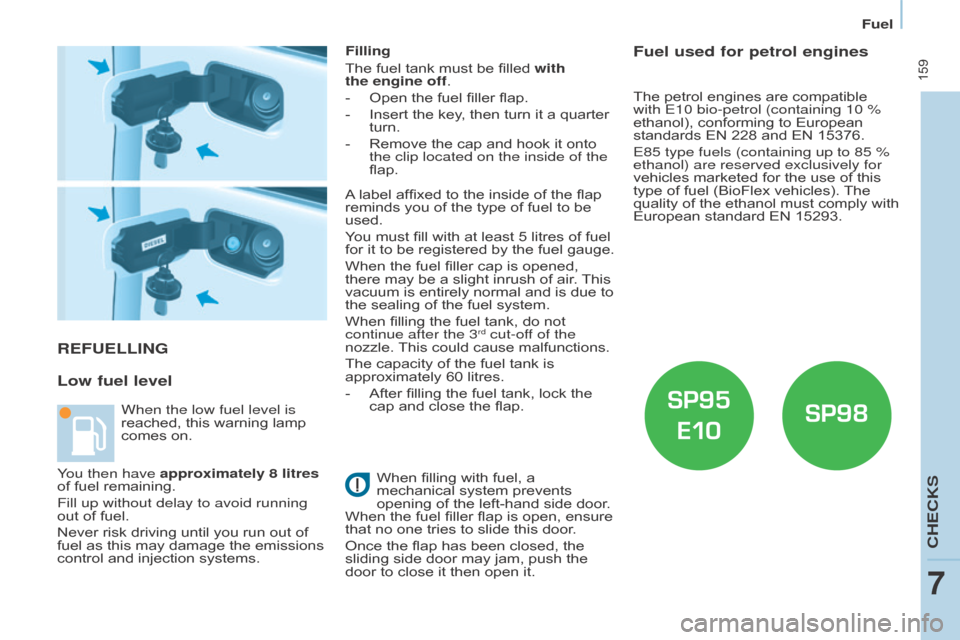
159
Berlingo-2-VP_en_Chap07_Verification_ed01-2015Berlingo-2-VP_en_Chap07_Verification_ed01-2015
REFUELLING
Low fuel level
Filling
The fuel tank must be filled with
the
engine off.
-
Open
the fuel filler flap.
-
Insert
the key, then turn it a quarter
turn.
-
Remove
the cap and hook it onto
the clip located on the inside of the
flap.
When
filling with fuel, a
mechanical
system prevents
opening
of the left-hand side door.
When
the fuel filler flap is open, ensure
that
no one tries to slide this door.
Once
the flap has been closed, the
sliding
side door may jam, push the
door
to close it then open it.
When the low fuel level is
reached,
this
warning
lamp
comes
on. A
label affixed to the inside of the flap
reminds
you of the type of fuel to be
used.
Y
ou must fill with at least 5 litres of fuel
for
it to be registered by the fuel gauge.
When
the fuel filler cap is opened,
there
may be a slight inrush of air.
This
vacuum
is entirely normal and is due to
the
sealing of the fuel system.
When
filling the fuel tank, do not
continue after the 3rd cut-off of the
nozzle.
This
could
cause malfunctions.
The
capacity
of
the
fuel tank is
approximately
60
litres.
-
After
filling
the
fuel tank, lock the
cap
and
close
the flap.
Fuel used for petrol engines
The petrol engines are compatible with E10 bio-petrol (containing 10 %
ethanol), conforming to European
standards
EN 228 and EN 15376.
E85 type fuels (containing up to 85 %
ethanol) are reserved exclusively for
vehicles
marketed for the use of this
type
of fuel (BioFlex vehicles).
The
quality
of the ethanol must comply with
European
standard EN 15293.
You then have approximately 8 litres
of
fuel
remaining.
Fill up without delay to avoid running
out
of
fuel.
Never
risk
driving
until
you
run
out
of
fuel
as
this
may
damage
the
emissions
control
and
injection
systems.
CHECKS
7
Fuel
Page 185 of 298

183
Berlingo-2-VP_en_Chap08_aide-rapide_ed01-2015Berlingo-2-VP_en_Chap08_aide-rapide_ed01-2015
Rear lamps
This procedure requires the use of
the spanner supplied with the tools for
changing a wheel.
When
refitting, take care to
reposition the tabs and the wiring
correctly to avoid trapping the
wiring.
a
fter changing the rear direction
indicator
bulb, the reinitialisation time is
above
2 minutes.
-
Move aside the 4 tabs then extract
the
bulb holder.
-
Remove
the faulty bulb by
pressing it lightly while turning it
anticlockwise.
-
Change
the bulb.
When
removing the lamp unit:
-
with
tailgate, pull the lamp unit
towards the centre of the vehicle,
-
with
hinged doors, pull the lamp
unit
towards you.
For
more
information
on
bulbs,
refer
to
the
"Types
of
bulb".
1.
Brake lamps / sidelamps
T
ype B,
P21/5W
-
21/5W
2.
Direction indicators
T
ype B,
PY21W
-
21W
(amber)
3.
Reversing lamps
T
ype B, P21W - 21W
4.
Foglamps
T
ype B, P21W - 21W
High pressure jet washing When using this type of washing
on stubborn dirt, do not persist on
the
headlamps,
the
other
lamps
and
their
edges
to
avoid
damaging
their
coating
and
seals. Chapter
9, "Changing a wheel"
section.
-
Identify the failed bulb, then open
the
rear doors to 180°.
Chapter
3, "Access" section.
-
Remove
the two fixing bolts using
the
spanner provided.
-
Pull
the lamp unit from the outside.
-
Holding
the lamp, disconnect the
electrical
connector.
QUICk HELP
8
Changing a bulb
Page 186 of 298

184
Berlingo-2-VP_en_Chap08_aide-rapide_ed01-2015Berlingo-2-VP_en_Chap08_aide-rapide_ed01-2015
Number plate lamps
- Unscrew the two nuts.
-
Push
the pins.
-
If necessary
, disconnect the
connector
to remove the lamp.
-
Change
the bulb.
Third brake lamp
Type A, W16W - 16W
T
ype A, W5W - 5W
With tailgate
-
d
isengage the plastic lens using a
screwdriver.
-
Change
the
bulb.
-
Replace the plastic lens and press
on
it. With hinged doors
-
Unclip
the
interior
trim.
-
d
isconnect the connector by
moving
aside
its
tab.
-
T
urn the bulb holder a quarter turn
anticlockwise.
-
Change
the
bulb.
-
Put
the
bulb
holder
back
in
place
and
reconnect
the
connector.
-
Put
the
trim
back
in
place.
Changing a bulb